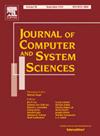How to tamper with a Parliament: Strategic campaigns in apportionment elections
IF 0.9
3区 计算机科学
Q1 BUSINESS, FINANCE
引用次数: 0
Abstract
In parliamentary elections, parties compete for a limited, typically fixed number of seats. Most parliaments are assembled using apportionment methods that distribute the seats based on the parties' vote counts. Common apportionment methods include divisor sequence methods (like D'Hondt or Sainte-Laguë), the largest-remainder method, and first-past-the-post. In many countries, an electoral threshold is implemented to prevent very small parties from entering the parliament. Further, several countries have apportionment systems that incorporate multiple districts. We study how computationally hard it is to change the election outcome (i.e., to increase or limit the influence of a distinguished party) by convincing a limited number of voters to change their vote. We refer to these bribery-style attacks as strategic campaigns and study the corresponding problems in terms of their computational (both classical and parameterized) complexity. We also run extensive experiments on real-world election data and study the effectiveness of optimal campaigns, in particular as opposed to using heuristic bribing strategies and with respect to the influence of the threshold and the influence of the number of districts. For apportionment elections with threshold, finally, we propose—as an alternative to the standard top-choice mode—the second-chance mode where voters of parties below the threshold receive a second chance to vote for another party, and we establish computational complexity results also in this setting.
如何篡改议会:分配选举中的战略运动
在议会选举中,各党派争夺有限的、通常是固定数量的席位。大多数议会都采用分配方法,根据各党派的得票数分配席位。常见的分配方法包括除数序列方法(如D'Hondt或Sainte-Laguë)、最大余数法和多数制方法。在许多国家,实行选举门槛是为了防止很小的政党进入议会。此外,一些国家的分配制度包括多个地区。我们研究了通过说服有限数量的选民改变他们的投票来改变选举结果(即增加或限制一个杰出政党的影响力)在计算上有多困难。我们将这些贿赂式攻击称为战略活动,并根据其计算(经典和参数化)复杂性研究相应的问题。我们还对现实世界的选举数据进行了广泛的实验,并研究了最优竞选活动的有效性,特别是与使用启发式贿赂策略相对的,以及关于阈值的影响和地区数量的影响。最后,对于有阈值的分配选举,我们提出了第二次机会模式,作为标准首选模式的替代方案,其中低于阈值的政党的选民获得第二次机会投票给另一个政党,我们也在这种设置中建立了计算复杂性结果。
本文章由计算机程序翻译,如有差异,请以英文原文为准。
求助全文
约1分钟内获得全文
求助全文
来源期刊

Journal of Computer and System Sciences
工程技术-计算机:理论方法
CiteScore
3.70
自引率
0.00%
发文量
58
审稿时长
68 days
期刊介绍:
The Journal of Computer and System Sciences publishes original research papers in computer science and related subjects in system science, with attention to the relevant mathematical theory. Applications-oriented papers may also be accepted and they are expected to contain deep analytic evaluation of the proposed solutions.
Research areas include traditional subjects such as:
• Theory of algorithms and computability
• Formal languages
• Automata theory
Contemporary subjects such as:
• Complexity theory
• Algorithmic Complexity
• Parallel & distributed computing
• Computer networks
• Neural networks
• Computational learning theory
• Database theory & practice
• Computer modeling of complex systems
• Security and Privacy.
 求助内容:
求助内容: 应助结果提醒方式:
应助结果提醒方式:


